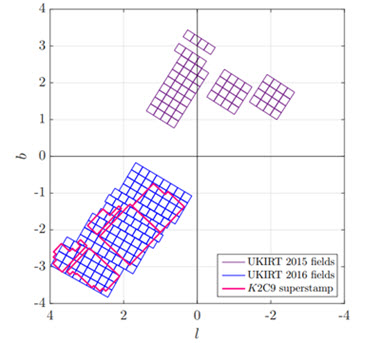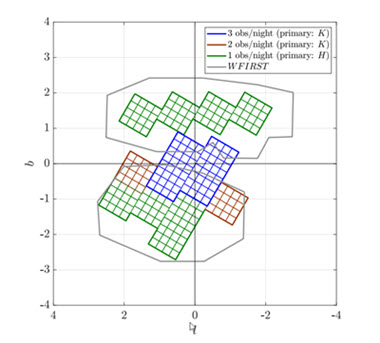UKIRT Coverage Maps and Magnitude Ranges

Here we include figures created by the UKIRT Microlensing Team that describe various aspects of the UKIRT microlensing survey, which are intended for public consumption and dissemination. We simply request that appropriate citations and credit are given if these are used in talks and presentations.
Click an image to download as PDF.
Observational Coverage Maps
 |
 |
Figure 1 - Distribution of target fields for the 2015 (northern Galactic bulge) and 2016 (southern Galactic bulge) UKIRT microlensing surveys (left panel), shown with the survey superstamp area (pink) for K2's Campaign 9 (K2C9), which can be found in the K2C9 white paper (cf. Figure 7): Henderson, C. B. et al. (2016) PASP, 128, 124401. Distribution of target fields for the 2017–2019 UKIRT microlensing surveys (right panel), shown with the WFIRST microlensing survey target field region (grey). In the right panel, the bold field lines demarcate the Galactic Bulge Regions. Specifically, the green fields with positive Galactic latitude are designated as northern Galactic bulge fields, all blue fields are designated as the central Galactic bulge fields, and both red fields and the green fields with negative Galactic latitude are designated as southern Galactic bulge fields. For all green fields, the primary filter is H-band, for which there is 1 epoch per night, and the secondary filter is K-band, for which there is 1 epoch every 5 nights. For all red fields, the primary filter is K-band, for which there are 2 epochs per night, and the secondary filter is H-band, for which there is 1 epoch every 3 nights. For all blue fields, the primary filter is K-band, for which there are 3 epochs per night, and the secondary filter is H-band, for which there is 1 epoch every 3 nights. |
|
Magnitude Ranges
| Filter | Bright Limit | Faint Limit |
|---|---|---|
| H-band | 11.5 | 19.0 |
| K-band | 11.5 | 18.0 |
Please note: These are approximate limits that take into account non-linearity and field-dependent background levels (arising from differential extinction).
Last updated: 16 January 2019




